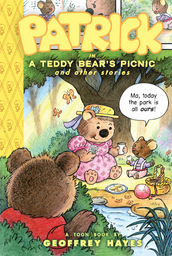 Patrick in "A teddy bear's picnic" and other stories by Geoffrey Hayes
Toon Books, 2010
Throughout the course this collection of short stories in graphic novel format, adorable young teddy bear Patrick goes on a picnic with his mother, encounters Big Bear the bully, and struggles with nap time.
First of all, the art is lovely. Hayes fills the pages with soft, colourful illustrations that are full of small details that make the most of the forest setting. The characters' expressions - especially those of Patrick and his mother - are a delight and provide a lot of the humour in the stories.
Hayes also uses a wide variety of graphic novel layouts, from full-page panels to a two-page spread containing 15 panels. While the book's language is at Level 2 (emerging reader), the complexity of the panel layouts is used wisely and in intuitive ways that guide and instruct the reader. Additionally, the helpful "tips for parents and teachers: how to read comics with kids" page at the back offers insights and suggestions for reading graphic novels with children.
The stories themselves are snapshots of Patrick's life. While the picnic is a special occasion, the activities Patrick partakes in - puddle-splashing, playing with a toy boat, blowing up balloons - are ones that children are familiar with. There is certainly a wholesomeness and whimsy on display here as there are no signs of electronics, but the addition of Big Bear the bully (who Patrick deals with in a healthy manner) keeps it from being too saccharine.
This may sound foolish, but the one thing that distracted me throughout the entirety of the book was Patrick's shirt: it can't be a turtleneck because the sides aren't high on the sides of his neck but the front is up past his chin. Does he have his shirt on backwards? I have no idea. All I know is I had to look twice at some panels to see which way was his front because it honestly looked like his head was turned all the way around. After doing a bit of research, it appears that Patrick has always had a purple shirt that's a bit odd around the neck in all of Hayes' Patrick books, even those from the 1980s. Nonetheless, I found it bizarrely distracting, for nothing if not the perceived discomfort of such attire.
Minor wardrobe issue aside, Patrick in A teddy bear's picnic and other stories is an engaging and timeless introduction to the graphic novel genre for blossoming readers.
**Review copy provided by publisher.
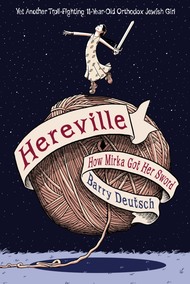 Hereville: how Mirka got her sword by Barry Deutsch
Amulet Books, 2010
Mirka wants to be a dragonslayer, but that profession doesn't exactly jive with her Orthodox Jewish upbringing. One day on her way to school, Mirka comes across a spectacular building with a woman floating in the front yard. When she tells her sisters and brother, they don't believe her so she finds the building again and picks a giant grape. Although the grape doesn't bite her, the giant pig who now follows her around might! How can she possibly get rid of it?
This graphic novel is a whole lot of fun, and I really appreciated how her religion and lifestyle played a large yet not oppressive role. Mirka's Yiddish sayings are defined at the bottom of the page, her family's beliefs are shown and explained clearly, and the conflict between her dream to be a dragonslayer and her family's beliefs was made evident. In fact, the tagline on the cover of the book really captures the sentiment throughout: "Yet another troll-fighting 11-year-old Orthodox Jewish girl." What's not to love about that?
The drawings themselves are line drawings with black ink, greys, and apart from the night-time scenes in grey-blues, the only colours are beige and an orange shade. I enjoyed Deutsch's style, which is fairly simple but with lots of expression and movement. There is a wide variety of panel layouts throughout, but they would be easy to follow and understand for even those who are new to graphic novels. I particularly adored how he drew the troll, and appreciated the back matter in which Deutsch showed how many iterations of the troll he went through before deciding on the final design.
Hereville should hold great appeal for upper elementary or middle grade students who like fantasy, or fans of graphic novels with strong female protagonists like Rapunzel's Revenge.
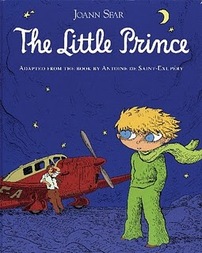 The little prince by Joann Sfar, adapted from the book by Antoine de Saint-Exupéry
Houghton Mifflin, 2010
A man is stranded in the desert with a broken-down airplane. He is asleep one night when the little prince awakes him with a request: "Please. Draw me a sheep." Thus begins a friendship between a human and a small alien boy who wants to return to his home planet and the flower that he loves.
Sfar's graphic adaptation of the classic book by de Saint-Exupéry is very faithful to the original text. True, the entirety of the text is not included, but many of the conversations, the planets that the little prince visits, and details like the drawings that the man does are the same. I haven't done a strict adaptation-to-original comparison, but a quick skim through de Saint-Exupéry's book indicates that the essence of his tale is contained in Sfar's work.
The little prince looks quite a bit different in Sfar's adaptation: he has huge eyes and a football-shaped head. The tousled blond hair and scarf remain the same, but Sfar's version of the little prince is more alien-looking than de Saint-Exupéry's. Of course, the little prince is an alien, and his appearance grew on me throughout the book and now I can hardly picture him otherwise.
Sfar's style of illustration is distinctive. There is an informal, almost sketch-like quality to his drawings, such as scribbles to indicate texture on the ground. I'm not sure if there is an actual straight line in the entire book, but the drawing are anything but haphazard. The angles Sfar uses, especially on the planets that the little prince visits, vary widely and give a sense of the space and atmosphere at each planet. I found his interpretations of the aliens and other characters strange and fascinating, especially the king on the first planet with his elephantine nose and the fox on Earth whose ears look identical to his fluffy tail. Admittedly, Sfar's style took a few pages for me to get used to, but I ended up really liking it.
While not a replacement for Antoine de Saint-Exupéry's work, Sfar's graphic novel adaptation of The little prince is a lovely introduction to or a lovely reminder of a timeless story that holds a spot in many hearts.
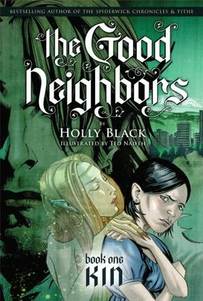 Kin (The good neighbors, book 1) by Holly Black (text) & Ted Naifeh (art)
Graphix, 2008
Rue's mother has been missing for three weeks and her professor father is becoming increasingly distant. Rue is struggling to live a reasonably normal life - going to school, hanging out with her friends - and ignore the strange creatures she keeps seeing. When her father is accused of murdering a young woman, Rue tries to get to the bottom of what really happened to the young woman as well as her mother, and finds far more than she bargained for.
I've been a fan of Holly Black since reading both The Spiderwick Chronicles and Tithe a few years ago, and Kin certainly reinforced to me her interest in and ability to write about humans (and people who initially believe that they are human) encountering the faerie realm. I have to say that I enjoyed both Tithe and The Spiderwick Chronicles more, however, and I'm having trouble putting my finger on why.
Naifeh's art, for one thing, is stunning. The style of both the drawing and the characters is distinctive, and the atmosphere is dark yet not particularly ominous. Rue's expressions and body language are exquisite, both of which lent meaning to her words. I also enjoyed the use of different perspectives and panel layouts throughout the book, and I appreciated how items seen early in the story turned up in a more significant way later on.
The story is more ominous than the drawings, and there is a sense of everything being not quite as it seems from the very beginning. Rue's character was well developed but Rue's parents played very little role other than causing plotting to happen, and I didn't have a sense of them as personalities. It seemed that way with many of the characters, but I'm hesitant to jump to that conclusion seeing as this is the first book in a series. Nonetheless, it felt to me as if Rue was the only "real" character in the book.
To be clear, I don't dislike Kin: it's gorgeous to look at and I am curious to see what's in store for Rue. I will seek out the sequels in the hopes that I enjoy them more.
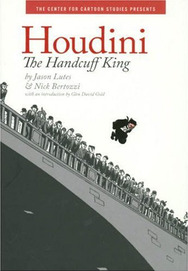 Houdini: the handcuff king by Jason Lutes & Nick BertozziThe Centre for Cartoon Studies, 2007It is 5:00am on May 1, 1908, and Harry Houdini is preparing for a handcuffed jump off of Harvard Bridge in Cambridge, Massachusetts. He checks the police-issued handcuffs, goes for a jog, and reviews the stunt plan with the police and his assistant. With the river almost freezing over and a large crowd expected, Houdini has his livelihood as well as his life at stake. The handcuff king is from the same publisher as my earlier-reviewed Amelia Earhart: this broad ocean, and it bears some striking similarities. Three colours are used in the drawings - in this case black, white, and a grey-blue - and there is a lengthy introduction by Glen David Gold, who wrote a biography about one of Houdini's contemporaries. Also, at the end of the book, there are more than four pages that provide supplementary details about specific panels in the book, from how the locks of the early 20th century worked to promotion and advertising during that time period. In fact, the back matter provides the context needed for this very brief glimpse into Houdini's life. The entire book spans the events of one day , and one stunt, in Houdini's career. It is a snapshot of the man he was, from his adoration of his wife Bess to the control he had over every single aspect of a performance, and an indication of his ability to attract huge crowds to his spectacles. The illustrations were detailed, particularly the crowd scenes, although I found the lettering style distracting. My favourite part of the book was when Houdini is struggling to escape from the handcuffs while underwater, which is shown on the panels at the edge of each page, and the reactions of the crowd and the ticking clock is shown in inner panels. It gives a distinct atmosphere of concurrent events and certainly increased the tension of the moment for me, and I appreciate how the Lutes and Bertozzi take this life-threatening stunt that would be a memorable event in most people's lives, and present it as a common occurrence in Houdini's life. The handcuff king is an accessible introduction to the life of a man that holds mystique for many, and in a format that students will be drawn to and learn from.
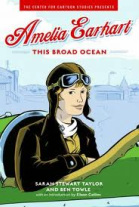 Amelia Earhart: this broad ocean, written by Sarah Stewart Taylor and James Sturm, illustrated by Ben Towle
Hyperion Books, 2010
Amelia Earhart departed on her historic 1928 voyage across the Atlantic from the small Newfoundland port town of Trepassey. After several days of false starts due to weather and other complications, Earhart became the first woman to fly across the Atlantic Ocean. This graphic novel tells Earhart's story - and her influence - through the eyes of Grace, a curious young girl of Trepassey.
The framing of this story works very well: Grace is intent on being a reporter (even among the real newspaper reporters sent to Trepassey from around North America) which reflects Amelia Earhart's determination to be the first woman to fly across the Atlantic, and I found myself wanting to see them both succeed. In fact, I was hoping that Grace and Earhart shared a second characteristic and that they were both real historical figures. Alas, there is no indication in the supporting information that Grace was a real person.
This broad ocean has a distinctive visual style with the use of only black, white, and a light turquoise colour in the illustrations. The drawings are simple in both their lack of colours and the lines used, but movement is well indicated. I am not sure if it was intentional, but Grace and Earhart bear a striking physical resemblance to one another with freckles and short, fly-away hair (truly, they have the same haircut except that Grace's is a touch longer), which undoubtedly contributed to my impression that Grace is the reflection of a young Earhart.
Despite some fictionalization in this graphic novel, there is quite a bit of supplementary information to the main text of the book for those who are curious to know more. Over four pages of discussion about individual illustrated panels found in the book are at the back, as well as a bibliography and selected reading list. The introduction by Eileen Collins, the first woman to pilot a space shuttle, is a personal testament to Earhart's impact in her own life and achievements.
Ultimately, this is a great introduction to Amelia Earhart's life and influence in a format that is popular with young students.
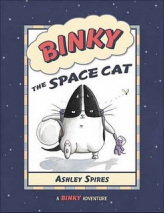 Binky the space cat by Ashley Spires
Kids Can Press, 2009
This book is hilarious and I adore it. That is all.
No, not really, but that is definitely my overall sentiment about this graphic novel for elementary-age children. Binky the cat, who trains ceaselessly (except for napping and eating, of course) to become an effective space cat who keeps the omnipresent "aliens" (bugs) away from his humans, has fast become my favourite cat in children's fiction.
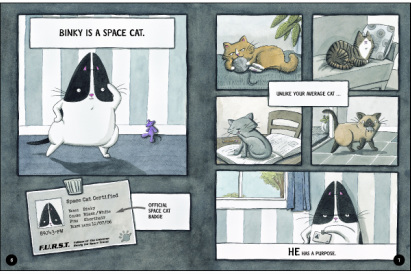 Image from: http://www.kidscanpress.com/US/Binky-the-Space-Cat-P3150.aspx The humour in this book is spot on, especially for anyone who has spent much time with a cat and knows their habits and quirks. The pages when Binky tries to help out around the house but manages to do quite the opposite is a hoot, as are Binky's attempts to dote on his humans. It has a Toy Story sensibility in the sense that Binky pursues his projects under the humans' noses without their knowledge, partaking in nighttime raids and research on the sly, complete with reading glasses stowed under the chair cushion. While some of the subtler jokes probably won't be caught by children, like the cover image homage to the inevitable slow-motion scene in Apollo 13 and the like wherein the astronauts stride heroically toward the spacecraft prior to take-off, Binky's "space gas" from eating particularly crunchy bugs will definitely get some giggles. Again, loved it, and I can't wait to get my hands on any other Binky books out there.
|








 RSS Feed
RSS Feed